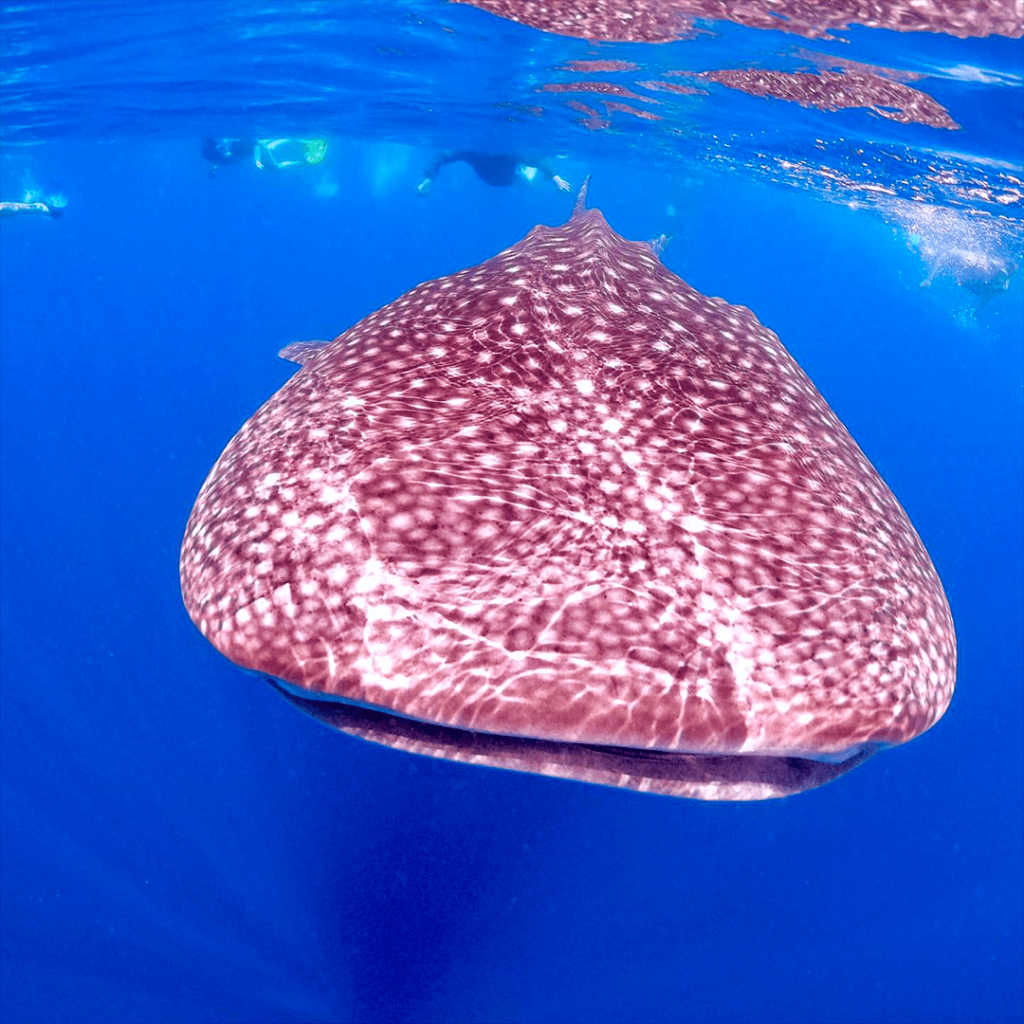Movements and Habitats of Whale Sharks
of East Africa:
Results of tagging studies in
2007 & 2008
Brent S. Stewart, Ph.D., J.D.
Hubbs-SeaWorld Research Institute
2595 Ingraham Street, San Diego, California, USA
Download the full Research Report Here
Introduction
The whale shark (Rhincodon typus) is the largest fish on Earth yet little is known
about its ecology and natural history. Some sharks appear briefly at several locations in
the Atlantic, Pacific, and Indian Oceans at various seasons and then vanish for most of
the year. Whale sharks have been known to occur along the Kenyan coast for some time
as evidenced by native narrative legend. Notice of them, and perhaps abundance, has
increased during (e.g., Ligon 1975, Wamukoya et al. 1995). They appear to be most
noticeable near-shore in southern Kenya from November through March and in
November along central and northern Kenya, though these apparent patterns may be
related to seasonal marine environmental conditions and consequent observation efforts.
In any event, their regular seasonal appearance in near-shore waters is stimulating an
increase in conservation concerns, scientific studies, and tourism interests to facilitate
interaction of humans with whale sharks. Information of the reasons whale sharks are
attracted to this area, what they do when they are resident, and where they go after
leaving is essential to aid development and execution of regional management and
conservation plans that will ensure harmonious co-existence of humans, their various
coastal activities, and whale sharks and other local and regional marine wildlife.
In November 2005 Hubbs-SeaWorld Research Institute (HSWRI) and the East
African Whale Shark Trust (EAWST) began a collaborative study of the ecology and
natural history of whale sharks that occur seasonally along the Kenyan coast (Stewart et
al. 2005). Follow up expeditions in 2007 and 2008 resulted in the deployment of
satellite-linked radio transmitters (archiva pop-up tags) to 20 sharks along Diani Beach
and near Watamu (Stewart et al. 2007; Stewart et al. 2008).
The long term objectives of this long-term collaborative project are to collect
systematic scientific observations to:
• Document seasonal and annual patterns of whale shark presence along Diani
Beach
• Determine the physical and oceanographic factors that influence and determine
the appearance of whale sharks along the Kenyan coast.
• Document the intra- and inter-annual occurrence of individual whale sharks
using small passive marker tags attached to sharks, photographic identification
methods using natural body markings and scars, and satellite linked data
recording and transmitting tags.
• Document migrations of whale sharks within the Indian Ocean Basin and to
other ocean basins using satellite tags and studies of molecular genetic markers.
• Engage local communities and schools in science-based education and
conservation programs for whale sharks and other elements of the coastal
marine ecosystem of the Kenyan coast.
• Promote global science-based education and conservation of whale sharks and
the marine ecosystems and habitats that they forage and reproduce in and
migrate through.
The near term goals of the project in 2007 and 2008 were to conduct a pilot study to
evaluate the utility of satellite-linked data recorders and transmitters for documenting
the geographic and vertical movements and habitats of whale sharks in the western
Indian Ocean and particularly along the coast of Kenya. I briefly report here the results
of those studies.
Methods
We attached pop-up archival (PAT, model PTT-100) satellite-linked data
recording and transmitting tags to 20 whale sharks along the coast of Kenya from in
February and March 2007 and 2008 (Stewart et al. 2007; Stewart et al. 2008; Figure 1).
Sixteen of those sharks were tagged near Diani Beach and the other four near Watamu
(Figure 1). The pop-up archival tag, or PAT, is a satellite-linked radio transmitter with
an integrated microprocessor data recorder that periodically measures and stores data
on ambient light, sea-water temperature, and hydrostatic pressure. These tags
remained tethered to each whale shark for a pre-programmed period (ca 9 months to 12
months in this study). Two fail-safe programs allowed the tag to detach and begin
transmitting data before the programmed date. If the tag remained at a constant or
narrow depth range (i.e., variation in depth < 20 m or floating at the surface) for four
days, it released from the tether attached to a shark and floated to the surface and began
transmitting. Also, if the tag reached a pressure of near 2000 psi (ca 1300 to 1400 m),
then the tag automatically detached from its tether (to prevent crushing of the buoyancy
float; the tags have been tested to 3000 psi = 2000m), floated to the surface, and began
transmitting.
The PATs stored data measured by the pressure (depth in meters), temperature
(°C), and light-level sensors as individual readings in non-volatile memory every two
minutes and then summarizes the events into broader time periods. The tags were
programmed to automatically detach from their tethers on particular dates. Once
detached, they would float to the sea-surface and then begin transmitting all of the
stored data to the earth-orbiting satellites in the Argos Satellite Data Collection and
Location Service (DCLS). The data transmitted by the tag to the earth-orbiting satellites
in the Argos DCLS system depended on the duration of the tag’s deployment. For tag
deployments of four months or less, sensor data at 15-minute intervals were transmitted.
For tag deployments of four to eight months, sensor data at 30-minute intervals were
transmitted, and for tag deployments exceeding eight months sensor data at 60-minute
intervals were transmitted. Those data were subsequently reported to the HSWRI
through a user agreement with Argos DCLS. The data recorded by the light level sensor
are initially processed by the tag’s software to estimate sunrise and sunset times. Those
summarized data were then transmitted through the Argos DCLS and further processed
to make daily estimates of latitude and longitude to allow a reconstruction of the
geographic movements of the animal. The recovered data on sea-surface water temperature were used to refine estimates of movements and also to generally define the thermal habitats that the sharks live in and travel through, and the data on hydrostatic pressure were used to reconstruct the general vertical habitats that whale sharks likely
forage in.
We attached the tags to the sharks with a small flat titanium dart that was
inserted into the sub-dermal fat layer. The tag was tethered to the dart with stainless
steel braided cable (ca 2 mm diameter, ca 20 to 30 cm long). We inserted the dart just
below the first dorsal fin of the shark (Figure 2) using an air-assisted spear gun, which
had a stop washer welded to the spear shaft about 10 cm from the tip of the shaft to limit
the penetration depth of the dart to within the fat layer, by snorkeling up to within a foot
of the shark when it approached the surface.
We located sharks from several spotter aircraft (a gyrocopter, a microlight, or
Cessna 172; Figure 3) which then directed, by radio contact, a small boat to just ahead of
the shark. Two swimmers using snorkel were then dropped off, swam towards the shark
and then attached the tag.
Results
Geographic movements:
We attached pop-up archival tags to 3 whale sharks in 2007 and 13 whale sharks
in 2008 near Diani Beach and to four whale sharks near Watamu in 2008 (Table 1).
Eight of the tags were programmed to detach from their tethers nine months after
attachment and the other 12 were programmed to detach one year after tagging (Table
1).
Satellite-radio contact was made with 16 of the tags between 10 and 388 days
after they were attached (Table 2). Radio contact was very brief with one of the tags
(915708) when it appeared in August 2008, about 170 days after the tag was attached.
The few transmissions from the tag did not provide any data on its location nor on the
geographic or vertical movements of the shark prior to detachment of the tag.
The locations of the other 15 sharks when the tags detached were all along the
coasts off east Africa (Kenya, southern Somalia, Tanzania, or Mozambique; Figure 5)
except for one tag that detached when the shark (8018008) was near the Seychelles
(Figure 19). Those tags relayed varying amounts of data which allowed the sharks
geographic movements to be determined for 10 to 388 days (Table 2; Figures 6 through
20). They ranged from off the southern coast of Somalia to the northern reach of the
Madagascar Channel
Sharks spent most of their time within or near Kenyan waters (Figures 21, 22)
through with the exception of one shark (80181) which moved offshore and eventually
toward the Seychelles (Figure 19). Overall, there was substantial overlap in the ranges of
individual sharks, though there did appear to be some local preferences among them
(Figures 23 through 36).
Download the full Research Report Here

